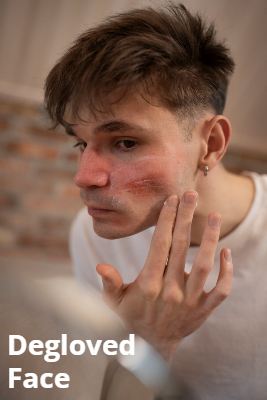A degloved face injury is a traumatic event that can have profound physical and emotional consequences. In this article, we delve into the complexities of degloved face injuries, exploring the causes, treatment options, and the journey of recovery.
What is a Degloved Face?
A degloved face injury occurs when the skin and underlying tissues are separated from the underlying bone and muscle, essentially “peeling” away from the face. This type of injury is often the result of high-impact accidents, such as car crashes, industrial mishaps, or falls.
Causes of Degloved Face Injuries
Understanding the causes of degloved face injuries is crucial for prevention and awareness. High-velocity accidents, workplace incidents, and severe falls are common culprits. Motor vehicle accidents, in particular, are a leading cause due to the forces involved.
Types of Degloving Injuries
Degloving injuries are classified into partial and complete degloving. Partial degloving involves the detachment of only a portion of the skin, while complete degloving involves the separation of the entire skin from the underlying structures.
Immediate Medical Response
In cases of degloved face injuries, immediate medical attention is paramount. Emergency responders and healthcare professionals work swiftly to stabilize the patient, control bleeding, and prevent infection. The primary goal is to preserve as much viable tissue as possible.
Surgical Interventions
Treatment often involves surgical interventions to reattach the degloved skin and tissues. Microsurgery may be employed to reconnect blood vessels and nerves, facilitating the restoration of blood flow and sensation to the affected areas. In some cases, skin grafts or tissue flaps may be necessary for reconstruction.
Post-Surgery Recovery
The recovery process for degloved face injuries is multifaceted. Patients may undergo physical therapy to regain mobility and strength. Psychological support is also crucial, as the emotional toll of such injuries can be significant. Support groups and counseling are often integral components of the recovery journey.
Challenges in Rehabilitation
Rehabilitation after a degloved face injury is not without challenges. Patients may face issues with facial muscle function, sensory changes, and scarring. Specialized care and ongoing medical support are vital to address these challenges and optimize long-term outcomes.
Psychological Impact
Beyond the physical aspects, the psychological impact of a degloved face injury should not be underestimated. Body image concerns, anxiety, and depression are common among survivors. Mental health professionals play a crucial role in helping individuals navigate these challenges and rebuild their self-esteem.
Assistive Technologies and Prosthetics
In cases where complete restoration is not achievable, assistive technologies and prosthetics offer innovative solutions. Advanced facial prosthetics aim to replicate natural features, providing both functional and aesthetic benefits to enhance the quality of life for survivors.
Legal and Financial Considerations
Navigating the aftermath of a degloved face injury often involves legal and financial considerations. Legal experts specializing in personal injury cases can assist in pursuing compensation for medical expenses, rehabilitation, and other associated costs.
Prevention and Safety Measures
While accidents leading to degloved face injuries are often unforeseen, preventive measures and safety protocols can mitigate risks. Emphasizing workplace safety, adhering to traffic regulations, and promoting awareness of potential hazards contribute to injury prevention.
Conclusion
In conclusion, a degloved face injury is a complex and challenging experience, necessitating a comprehensive approach to treatment and recovery. Immediate medical attention, surgical interventions, rehabilitation, and psychological support are integral components of the journey towards healing. By understanding the causes, treatments, and challenges associated with degloved face injuries, we can foster greater awareness and contribute to the well-being of survivors.
Frequently Asked Questions
Can all degloved face injuries be surgically repaired?
Surgical intervention is often a primary treatment, but the extent of repair depends on the severity of the injury and individual factors.
What is the typical recovery time for face injuries?
Recovery times vary, with factors like the extent of the injury and individual healing capabilities influencing the timeline.
Are there long-term effects of face injuries?
Long-term effects may include scarring, changes in facial sensation, and potential challenges with facial muscle function.
Can psychological support help with the emotional impact of such injuries?
Yes, psychological support is crucial for addressing the emotional toll and helping individuals cope with the aftermath of a face injury.
Are there preventive measures individuals can take to avoid such injuries?
While accidents are often unpredictable, promoting safety measures in various settings, such as workplaces and roads, can reduce the risk of face injuries.




